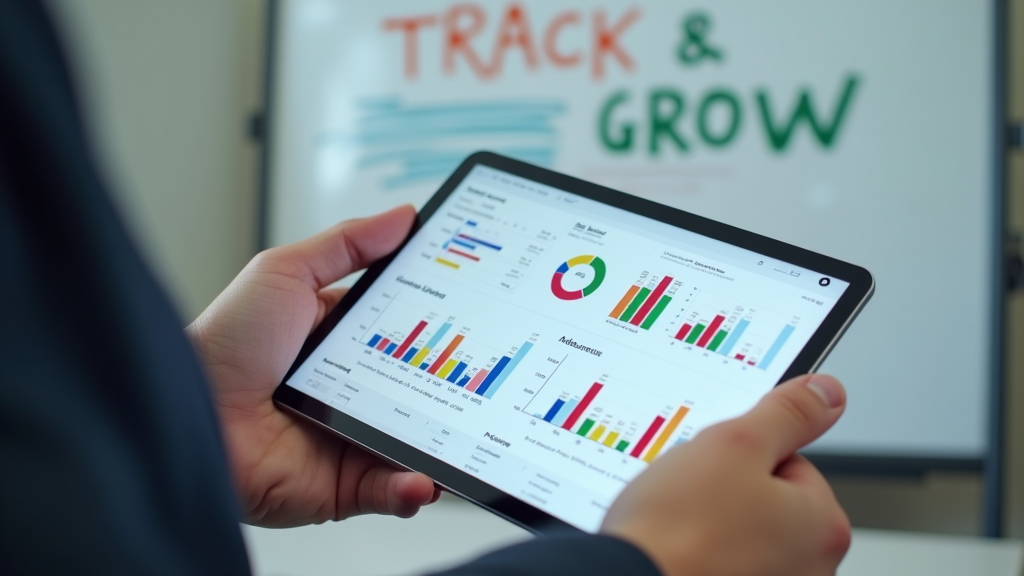Understanding Conversion Rate: A Complete Guide
Master the essentials of conversion rate optimization with actionable insights and proven strategies to transform your website visitors into valuable customers.

Introduction
Your website gets plenty of visitors, but they leave without buying anything or signing up. This common problem affects many businesses online. You work hard to bring people to your site through social media, email marketing, and search engines. But turning these visitors into actual customers feels like an uphill battle.
We understand this challenge and want to help you fix it. By learning about conversion rate optimization, you’ll discover simple ways to convince more visitors to take action on your website. The good news is that even small changes can lead to big improvements in your sales and signups. Let’s explore how you can start turning more of your website traffic into real business results.
What Is Conversion Rate
Your conversion rate shows how many website visitors take the action you want them to take. It’s a simple number that tells you if your website is doing its job. The conversion rate formula is straightforward: divide the number of conversions by total visitors and multiply by 100. For example, if 300 people visit your online store and 30 make a purchase, your conversion rate is 10%.
Different actions count as conversions based on your goals. A conversion might be someone buying your product, signing up for your email newsletter, downloading your app, or filling out a contact form. Your website can have multiple conversion rates for different actions. An online course might track both free trial sign-ups and full course purchases, while an ecommerce store might monitor both cart additions and completed sales.
Understanding your conversion rate helps you make smart business decisions. A higher conversion rate means you’re getting more value from your existing traffic, which can lead to more sales without spending extra money on advertising. It’s like having a store where more browsers become buyers. By tracking your conversion rate, you can test changes to your website and see what actually works to increase sales or sign-ups.
Industry Benchmarks 2024
You need conversion rate benchmarks to know if your business is doing well or needs improvement. These numbers help you set realistic goals and spot opportunities to get better results from your marketing efforts.
Here are the current average conversion rates by industry:
- Ecommerce: 2% to 3% for retail websites
- SaaS: 3% to 5% for free trial signups
- Education: 4% to 6% for course enrollments
- B2B: 2% to 5% for lead form submissions
- Lead Generation: 3% to 6% for service inquiries
Your actual conversion rates might be different from these benchmarks. Several things can change how well your website converts visitors into customers. The quality of your traffic matters a lot. Visitors who find you through Google searches often convert better than those from social media. Your pricing, competition, and target audience also play big roles. A website selling luxury items usually has lower conversion rates than one selling everyday products.

Measuring Your Performance
You need good tools to understand how well your website turns visitors into customers. Google Analytics 4 helps you see who visits your site and what they do there. Heat mapping tools like Hotjar show you where people click and how far they scroll on your pages.
Your conversion rate tells part of the story, but other numbers matter too. Your bounce rate shows how many people leave your site right away. Time on page tells you if visitors are reading your content or just passing through. These numbers help you spot problems and find ways to keep visitors interested.
Setting up conversion tracking might sound hard, but it’s actually simple. Start by deciding what actions you want visitors to take, like signing up for your newsletter or buying a product. Then use your analytics tool to track these specific actions. This gives you clear data about what’s working and what needs to change on your website.
Common Conversion Killers
Your website might be getting traffic, but if visitors aren’t taking action, there could be some common problems getting in the way. Poor website performance can cost you sales and leads. When your website works well, more visitors will stay longer and complete important actions like signing up or buying products.
- Slow Loading Speed: Pages that take more than 3 seconds to load cause visitors to leave quickly
- Complex Forms: Long forms with too many required fields discourage people from completing them
- Unclear Value Proposition: Visitors need to understand quickly what makes your product or service worth their time
- Poor Mobile Experience: Websites that don’t work well on phones frustrate mobile users and lead to lost sales
You can find these problems using website analytics tools like Google Analytics or Hotjar. Look for pages where visitors leave quickly or abandon their shopping carts. Check how long your pages take to load and watch recordings of how people use your website. This information will help you spot and fix the issues that stop people from converting.
Optimization Fundamentals
Your website needs to be easy to use if you want visitors to become customers. A confusing menu, slow loading pages, or hard-to-find buttons can make people leave your site quickly. Think about your own experience: you probably close websites that are hard to use or take too long to load.
You can find out what works best on your website through A/B testing. This means creating two versions of something (like a button or headline) and seeing which one gets better results. For example, you might test a green “Buy Now” button against a blue one to see which color gets more clicks. This helps you make smart choices based on real data instead of guessing what your visitors want.
Customer feedback plays a big role in conversion optimization. Your visitors can tell you exactly why they didn’t complete a purchase or sign up for your newsletter. You can collect this feedback through simple surveys, customer service conversations, or website feedback forms. These insights help you understand what stops people from converting and how to fix those problems.

Proven Optimization Tactics
Getting more visitors to take action on your website starts with using methods that actually work. Many successful businesses have found specific tactics that consistently lead to better results.
1. Write Clear Call-to-Action Buttons
Your buttons should tell visitors exactly what will happen when they click. Instead of “Submit,” try specific phrases like “Start My Free Trial” or “Get My Discount Code.”
2. Show Social Proof
Add customer reviews, ratings, or testimonials near your important buttons or forms. People trust other customers’ experiences and are more likely to take action when they see positive feedback.
3. Create Urgency
Let people know about limited time offers or low stock levels. Messages like “Only 3 seats left” or “Offer ends tonight” can help visitors decide faster.
4. Simplify Your Forms
Ask only for essential information. Each extra form field can make people less likely to complete it. If you need a phone number, explain why.
5. Build Trust
Display security badges, payment logos, and guarantees. If you accept PayPal or other trusted payment methods, show their logos prominently.
To improve conversion rate effectively, start by testing one tactic at a time. This helps you understand which changes make the biggest difference for your website. Keep track of your results and adjust your approach based on what works best for your visitors.
Real Success Stories
Let’s look at how some popular companies improved their conversion rates with smart changes to their websites.
Shopify found that many customers left their site before buying because the checkout forms were too long. They simplified their forms by removing unnecessary fields and adding a progress bar. This simple change helped about 50% more customers complete their purchases.
When HubSpot wanted more people to try their software, they added customer reviews and testimonials to their trial signup page. They showed real feedback from happy customers, which made new visitors feel more confident about signing up. This led to a 35% increase in people starting free trials.
Airbnb noticed that listings with professional photos got more bookings. They helped hosts improve their property photos by sharing photography tips and guidelines. Better photos made a big difference, increasing booking rates by 25%. This shows how good visuals can help convince people to make a purchase.
Advanced Strategies
Your website visitors want content that speaks to their needs. Personalization helps you show the right message to the right person at the right time. You can start by grouping your visitors based on their behavior, location, or how they found your site. For example, showing different homepage content to new visitors versus returning customers can increase your conversion rates.
Small wins add up to big results through micro-conversions. These are the little actions visitors take before making a purchase or signing up. Things like downloading a PDF, watching a product video, or adding items to a wishlist show that visitors are interested in what you offer. By tracking these actions, you can understand which content helps move people toward your main conversion goals.
Understanding how different marketing channels work together helps you make better decisions. Multi-channel attribution looks at all the ways people interact with your business before converting. A visitor might first find you through Google, then follow you on social media, and finally convert after getting your email newsletter. Knowing these patterns helps you invest in the channels that work best together to drive conversions.
Conclusion
Converting website visitors into customers takes time and consistent effort. You’ve learned about the key elements that influence conversion rates, from page speed to compelling calls to action. By making small improvements to these areas, you can start seeing better results from your existing traffic.
Start by picking one area to improve this week. Maybe it’s creating a better landing page or testing different button colors. Small changes often lead to big results when you track and measure what works for your specific audience.
SEO Tool Factory’s conversion tracking tools can help you measure these improvements quickly. Our simple analytics show you exactly which changes increase your conversion rates, and our A/B testing tool lets you try new ideas without any technical knowledge. You’ll see what works best for your website and can make smart decisions based on real data from your visitors.
FAQ
What’s a good conversion rate?
Your conversion rate will vary based on your industry and what you’re trying to achieve. For example, email signup forms typically see higher conversion rates than product purchases. While some businesses see 1% conversion rates, others might reach 5% or higher. Focus on improving your current numbers rather than chasing industry averages.
How long does optimization take?
You’ll typically need at least 2 to 4 weeks per test to gather useful data. Some changes show results quickly, while others need more time to prove their worth. The key is to be patient and let your tests run long enough to get reliable results. Your testing timeline will depend on your website traffic and the size of the changes you’re making.
Do I need expensive tools?
No, you can start with free tools like Google Analytics and Google Optimize. These give you solid data and testing capabilities without spending money. As your needs grow, you can look into paid tools that offer more features. Many small businesses get good results using just free tools.
How often should I test?
Run one test at a time to know exactly what’s working. Testing too many things at once makes it hard to know what actually improved your results. A good rule is to run a new test every month or two, giving each change enough time to prove itself. This helps you make steady improvements without overwhelming your team or visitors.
Mobile vs desktop conversion rates?
Mobile conversion rates are usually lower than desktop, but mobile traffic is often higher. Your website needs to work well on both. Focus on making forms shorter on mobile and reducing page load times. Remember that mobile users might research on their phones but buy later on desktop. This means tracking both platforms to understand your full conversion picture.